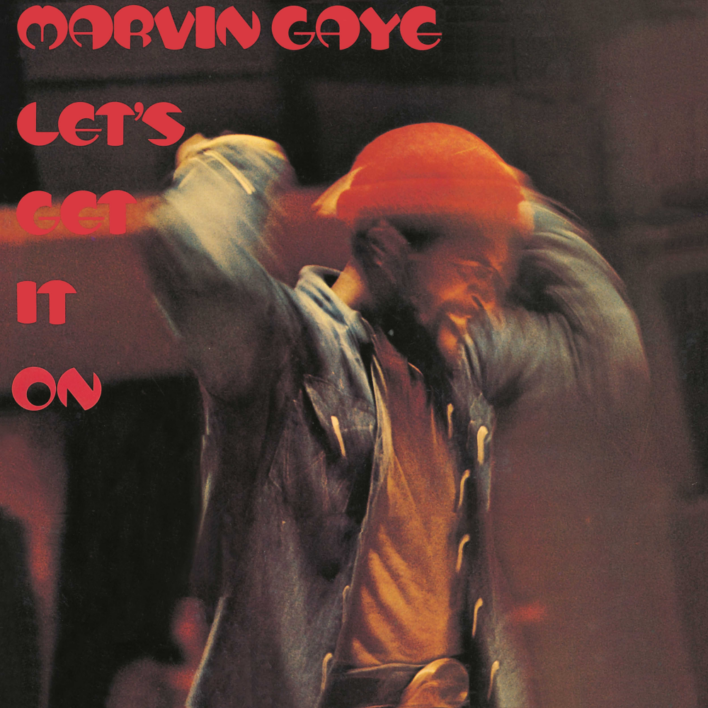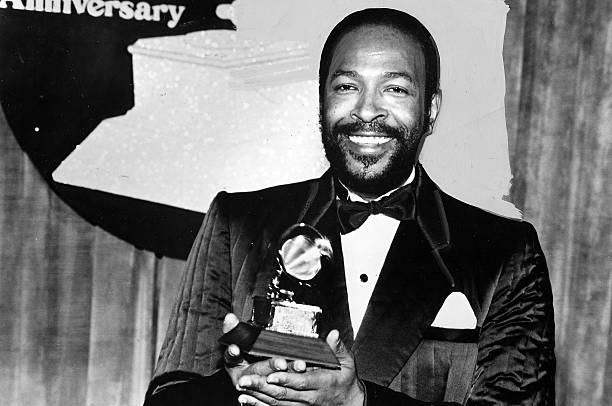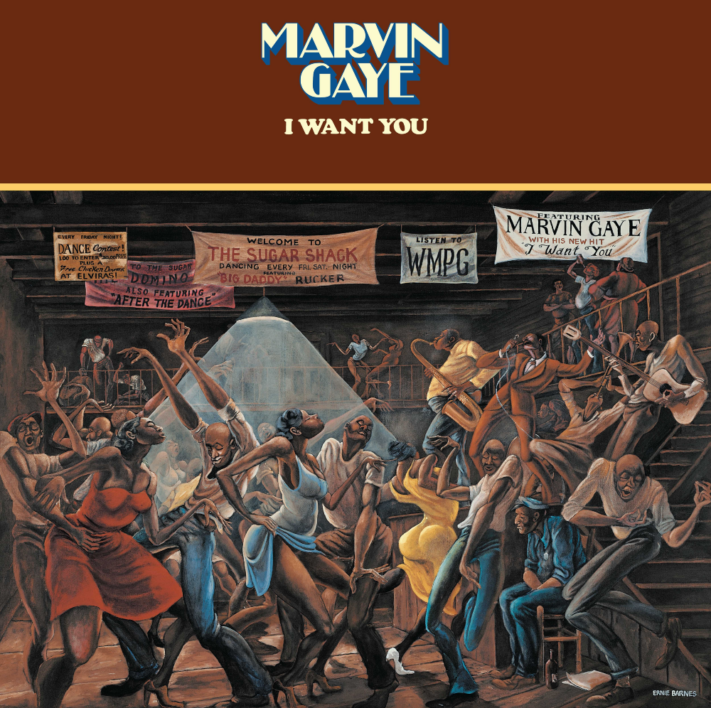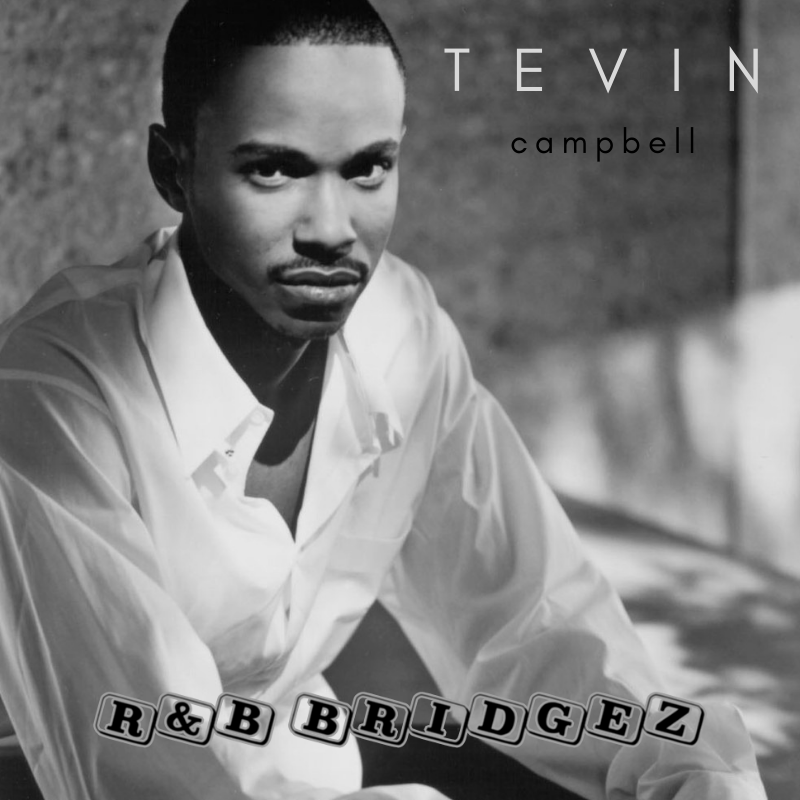R&B Bridgez: Celebrating The Incomparable Marvin Gaye
We Celebrate The Musical Genius On His Birthday.
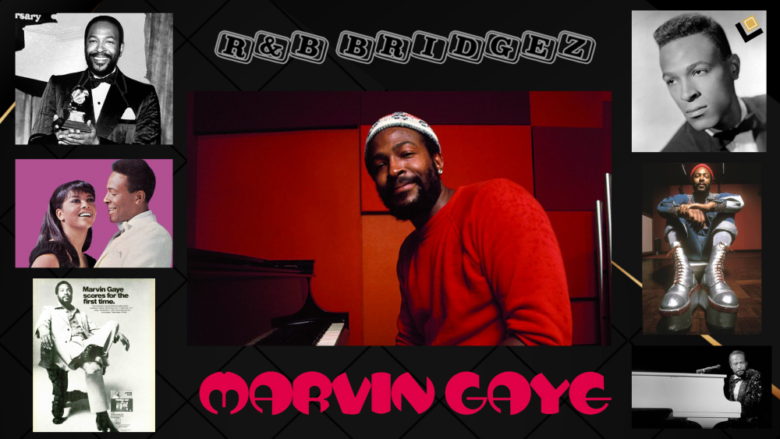
Today is the birthday of legendary Marvin Gaye, born April 2nd, 1939.
As one of the pioneers of Motown, singer/songwriter and musician/producer Marvin Gaye helped shape the sound of R&B/Soul music and is considered one of the greatest artists of all time.
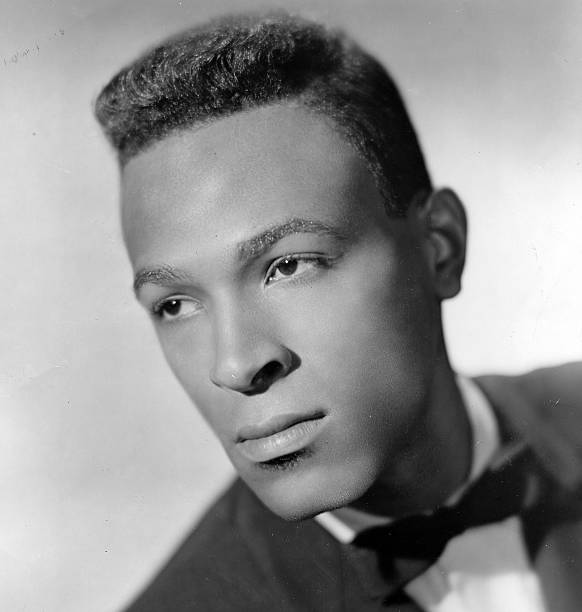
Marvin Pentz Gay, Jr. was born in Washington D.C. to Marvin Gay, Sr., a preacher, and Alberta Gay, a housewife and schoolteacher. The middle child of three children, Marvin Gaye’s childhood can be characterized by developing an early love of music in the face of an abusive relationship with his father.
Marvin Gaye’s introduction to music began by singing in his father’s church choir when he was only three years old. He expanded his musical abilities by learning how to play the piano and drums.
To escape the repeated beatings he endured at the hands of his father, Marvin Gaye dropped out of high school and enlisted in the Air Force.
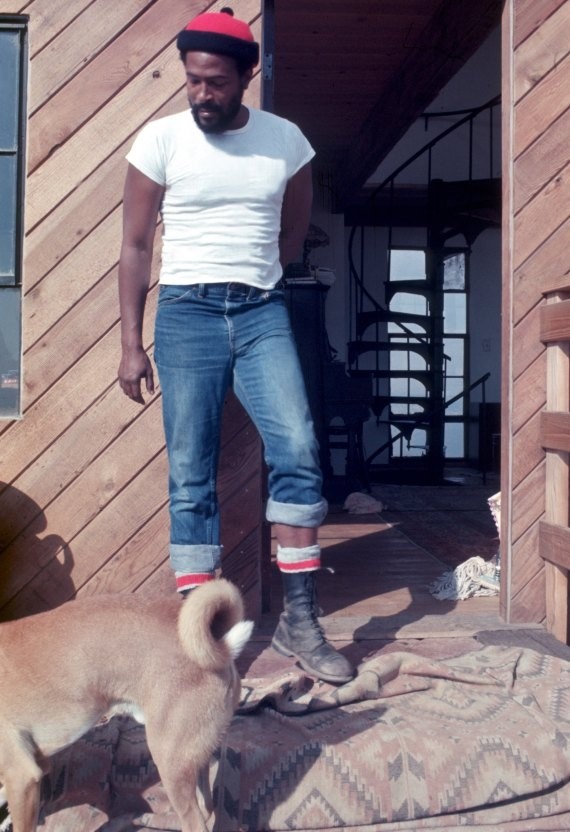
Never losing his love of music, he began singing in doo-wop groups when he was honorably discharged from the Air Force. He joined a local Washington D.C. band, and their song, “Wyatt Earp”, recorded with Okeh Records, led to an invitation to join Harvey Fuqua’s group, The Moonglows, in 1958.
The group moved to Chicago and began recording for Chess Records. Marvin Gaye then caught the attention of Barry Gordy Jr. during a Motown Christmas party where Marvin played the piano.
Gordy signed Marvin Gaye to Motown Records in 1961.
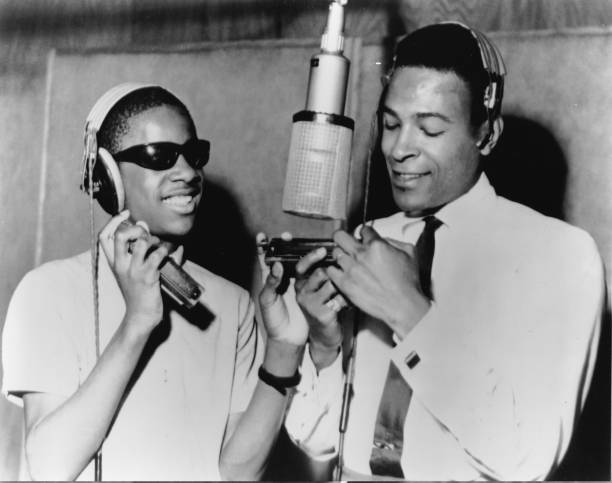
Marvin Gaye’s career began slowly with Motown, working as a session drummer while trying to build a solo career.
He played drums with such artists as The Miracles, The Contours, and Martha and the Vandellas.
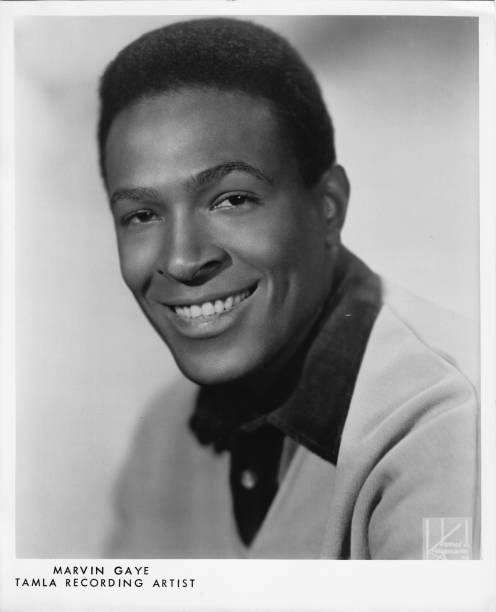
In 1961, Marvin released his first single, “Let Your Conscience Be Your Guide” followed by the album “The Soulful Moods of Marvin Gaye.” Both found no success on the national level, although they maintained moderate acclaim regionally.
Even though Marvin Gaye struggled with creative differences with Motown Records, he steadily churned out chart topping hits.
In 1962, he released “Stubborn Kind of Fellow”, which reached the Top 50 of the Billboard charts. The following year, “Hitch Hike” and “Can I Get a Witness” both reached the Top 30. “Pride and Joy” became his first Top 10 hit.
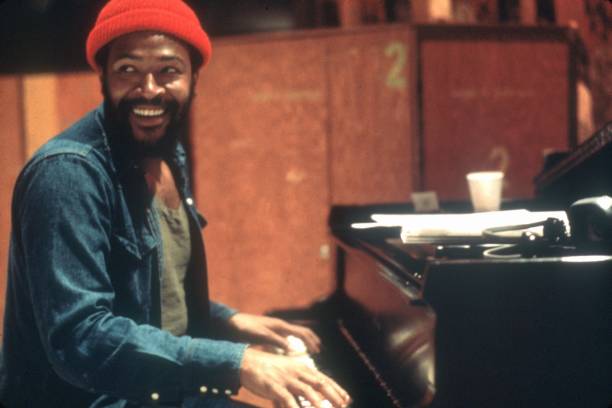
While his solo career was taking shape, Marvin Gaye collaborated in several duets.
In 1964 he did a successful duet album with Mary Wells entitled “Together.” The songs “Once Upon A Time” and “What’s The Matter with You Baby?” were also hit singles with Mary Wells.
However it was with Tammi Terrell, that Marvin‘s earned his biggest duet hits.
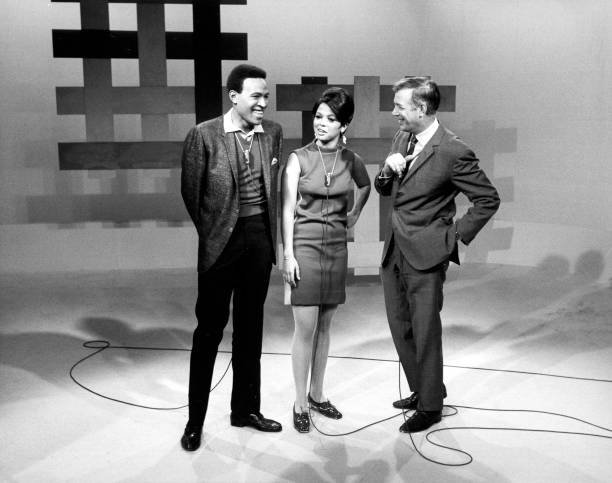
Together they performed 1967’s “Ain’t No Mountain High Enough” and “Your Precious Love” followed by 1968’s “Ain’t Nothing like the Real Thing” and “You’re All I Need to Get By.”
“Ain’t No Mountain High Enough” was written by Nickolas Ashford and Valerie Simpson in 1966. The song was later re-recorded by Diana Ross in 1970.
Tragically, Terrell collapsed onstage while performing with Marvin Gaye. It was later discovered that she was suffering from a brain tumor. Her illness and subsequent death on March 16, 1970 ended Marvin’s desire to collaborate on any more duets.
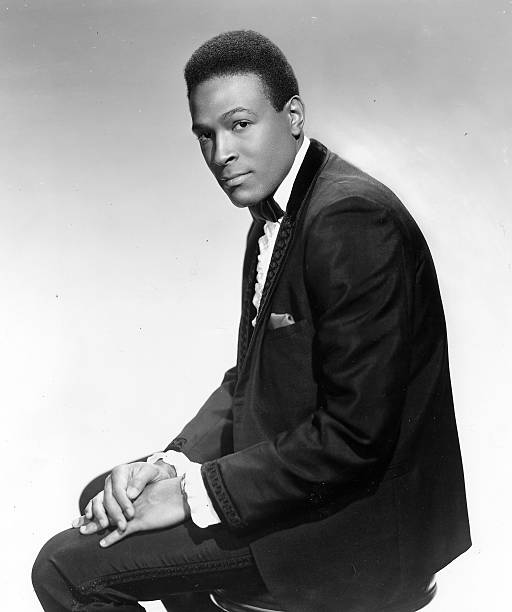
The loss also triggered bouts of depression and suicide threats. During this difficult period, Marvin Gaye had his biggest hit yet in 1968 with “I Heard It Through the Grapevine.”
He refused to acknowledge its success, even though it sold over 4 million copies.
With the release of 1969’s “Too Busy Thinking About My Baby” and “That’s the Way Love Is”, Marvin Gaye became increasingly frustrated with the type of music he was making with Motown, even though his songs kept making the charts.

He wanted to make more socially relevant music, so in 1971 “What’s Going On” was released.
It was the first song Marvin Gaye produced himself.
The album explored topics such as poverty, discrimination, politics, drug abuse and the environment.
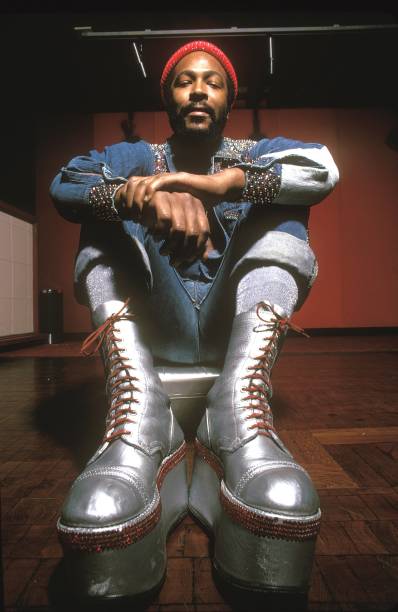
Barry Gordy was reluctant to release the album because he doubted its potential commercial success.
Despite the reservations, “What’s Going On” was an instant hit and groundbreaking work in the soul music genre.
The inspiration for the song came from Marvin Gaye’s brother Frankie, who told him stories of his service during the Vietnam War.
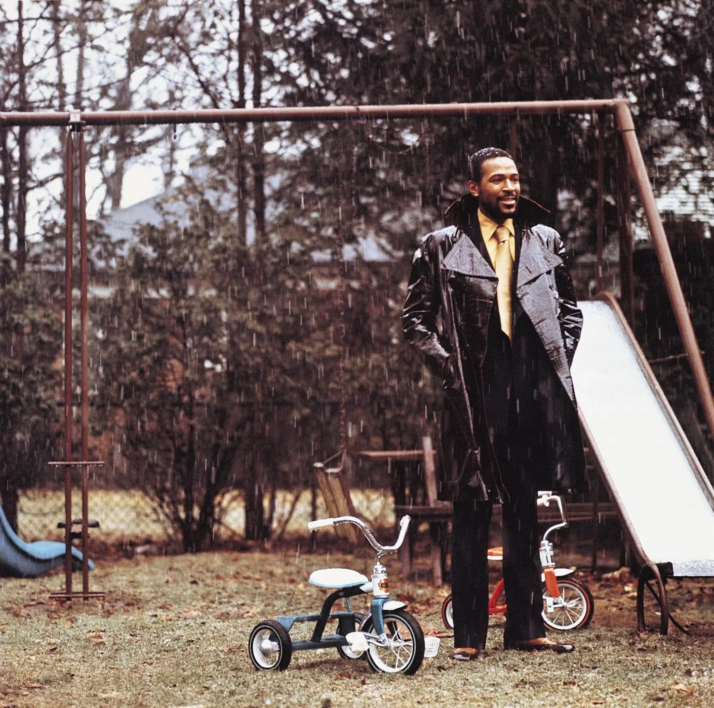
In 1972, Marvin Gaye was on top: or so it seemed. “What’s Going On,” “Mercy Mercy Me (The Ecology),” and “Inner City Blues (Make Me Wanna Holler”),” the three singles from his universally acclaimed album “What’s Going On,” had each hit #1 on Billboard’s Hot Soul Singles chart and Top 10 Pop the year before.
His follow-up, “You’re The Man” – a percolating, sarcastic riff on political non-action issued as the U.S. presidential campaign was kicking off – reaching #7 on Billboard’s Hot Soul Singles chart. He saw Motown schedule a “You’re The Man” album.
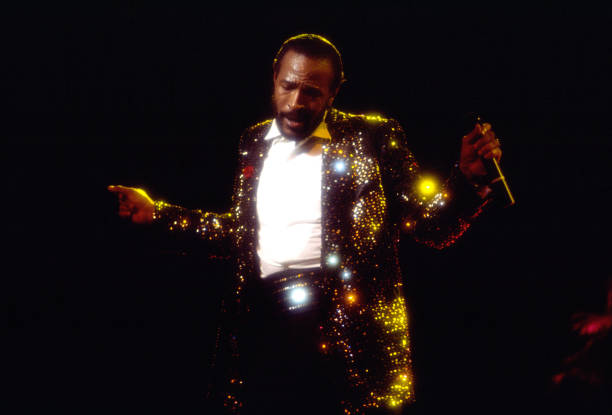
But when the lead single didn’t cross over Pop, stalling at #50, Marvin retreated and shelved the album. It was released posthumous in 2019.
Biographer David Ritz delved into Marvin’s deeply personal internal conflict as a source of creative vigor and emotional burden as he experienced “What’s Going On’s” massive success and all that came with it. “Now I could do what I wanted,” Marvin Gaye told Ritz. “For most people that would be a blessing. But for me the thought was heavy. They said I’d reached the top, and that scared me because Mother used to say, ‘First ripe, first rotten.’ When you’re at the top there’s nowhere to go but down. No, I needed to keep going up – raising my consciousness – or I’d fall back on my behind. When would the war stop? That’s what I wanted to know – the war inside my soul.”

Despite his inner turmoil, that same year Marvin Gaye recorded a duets album with Diana Ross, and he accepted an offer to write what became his landmark “Trouble Man” soundtrack to the 1972 blaxploitation film.
In 1973 Marvin Gaye changed his focus from social and political issues to more personal topics.
His personal life was falling apart. His more than ten year marriage to Barry Gordy’s sister, Anna, was coming to an end.
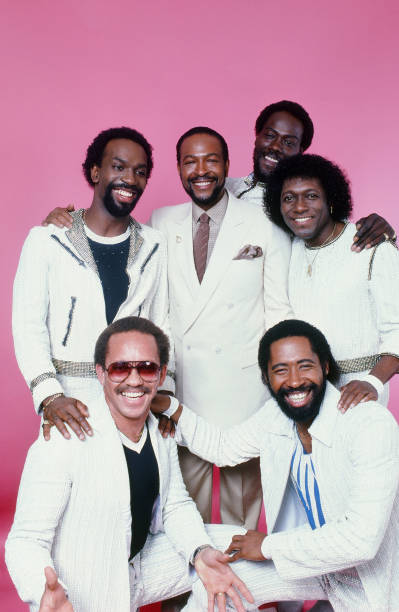
After their separation, the album “Let’s Get It On” surprised fans and critics with its sensual and erotic messages. The title track was a #1 hit.
Written by Marvin Gaye and Ed Townsend, considered one of the top romance songs of all time.
Ambivalent about recording, stubborn about moving to Los Angeles with Berry Gordy and Motown, Marvin by his actions proclaimed no more new Marvin Gaye music.

The eventual divorce of Marvin and Anna delayed release of his next album, “I Want You,” also with sexually charged subjects, in 1975.
After battling in divorce court, he was ordered in 1976 to pay a large percentage of the royalties of his next album to his ex-wife to cover alimony payments.
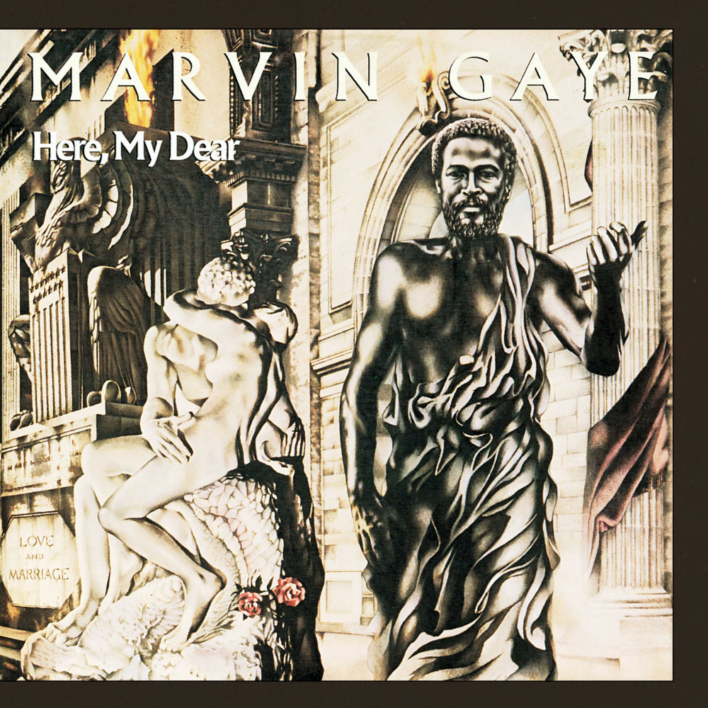
That album, 1978’s “Here, My Dear,” chronicled his failed marriage in such detail that it nearly led to a lawsuit for invasion of privacy.
“Got to Give It Up” is a disco song written by Marvin Gaye in 1977. Originally titled “Dancing Lady”, it began as an almost twelve minute song for a live double album.

Even though Marvin Gaye was pressured by Motown to record a disco song, it hit #1 on the Billboard charts. He sang both lead and background vocals.
Despite acting offers that were coming in, Marvin Gaye refused to play the Hollywood game; “No doubt I could have been a Hollywood star, but it was something I consciously rejected. Not that I didn´t want it. I most certainly did. I just didn´t have the fortitude to play the Hollywood game and put my ass out there like a piece of meat,” Marvin once stated in an interview.
Turmoil surrounding Marvin Gaye’s life continued from the late 1970’s into the 1980’s.
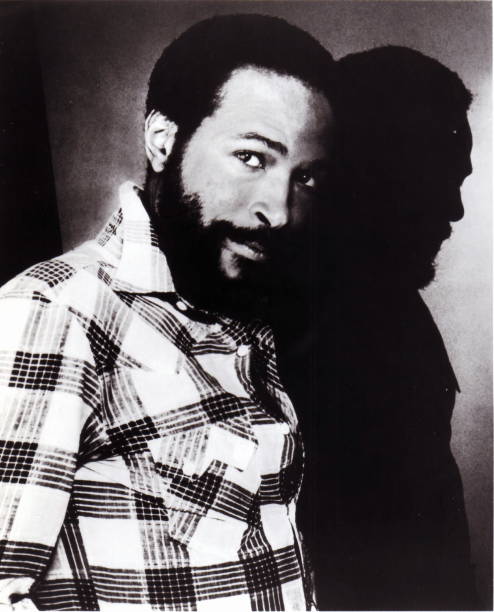
He moved to Hawaii when his second marriage failed, and continued his battle with drug addiction.
He then relocated to Europe.
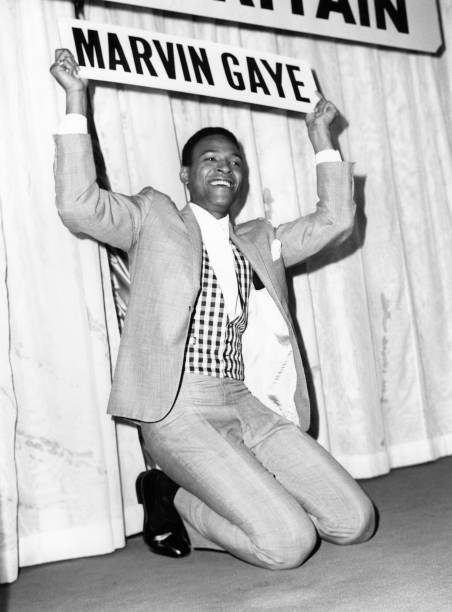
While in Europe, Marvin Gaye wrote “Our Lifetime,” which was the catalyst that ended his nearly 20 year relationship with Motown Records.
He contended that changes were made to the album without his consent. Much of the content was remixed and edited, and the title was changed to exclude a question mark that Marvin Gaye intended for irony.
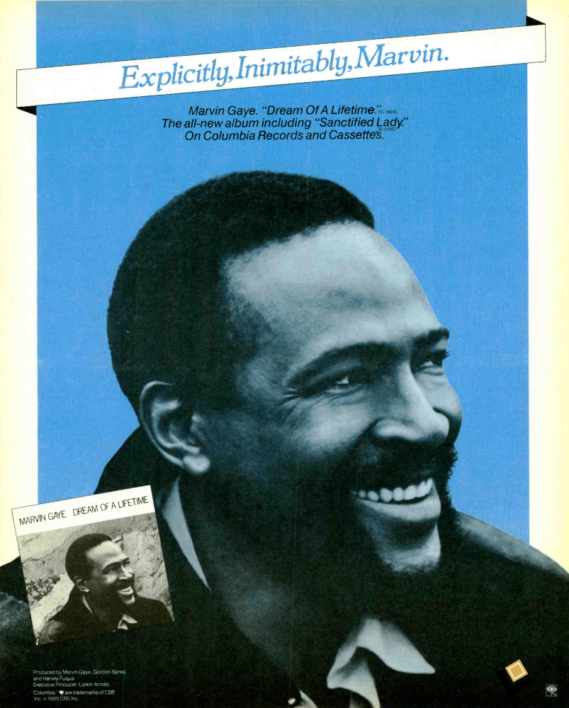
The last two years of Marvin Gaye’s life were filled with a combination of successful music and increasing drug problems.
Marvin once stated; “There are still times I feel unhappy and I must smile, and there are times I want to cry and I must laugh… people rarely see the real Marvin Gaye.”
He signed with Columbia Records in 1982 and released the classic “Midnight Love.”
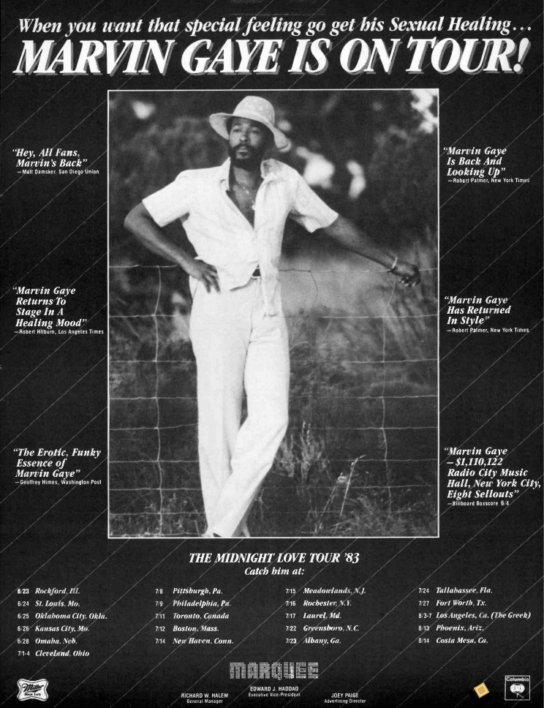
It includes the monster hit “Sexual Healing,” which earned Marvin Gayehis only Grammy Award and topped the charts in the US, Canada, New Zealand and the United Kingdom.
Spending a staggering ten weeks at #1 on the Billboard R&B charts, and won two Grammy Awards in 1982 for Best R&B Vocal Performance and Best R&B Instrumental.
“As an artist you want to record songs you feel strongly about. But, in my case, I don’t think commercially. As a record man, Larkin Arnold thinks commercially and since he and CBS have been so marvelous to me, I decided to give them artistic control,” Marvin stated after the release of “Midnight Love.”
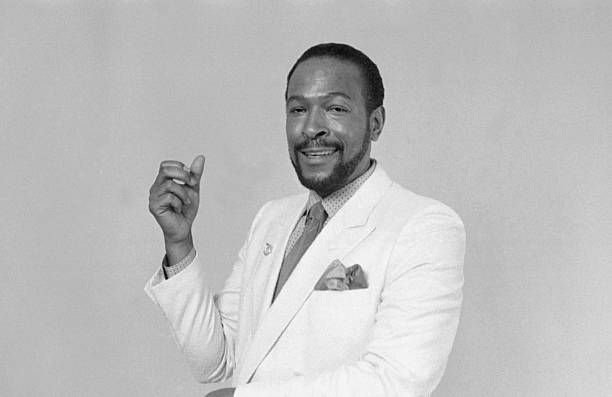
Then in 1983 he reconciled with Barry Gordy on a televised appearance celebrating “Motown’s 25.”
His last public appearance was in 1983 when he sang a classic original rendition of “The Star Spangled Banner” at the NBA All-Star game.
Cocaine addiction forced Marvin Gaye to move in with his parents to try to straighten out his life.
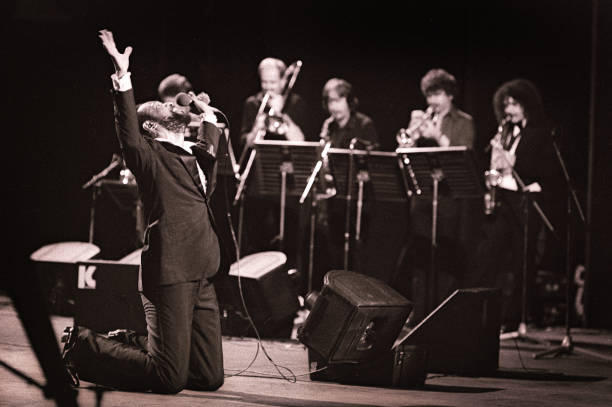
His strained relationship with his father, though, led him to sink even deeper into depression and thoughts of suicide.
During an intense argument on April 1st, 1984, Marvin Gaye was shot by his father, only hours before his 45th Birthday.
Citing self-defense, Marvin Gay Sr. plead no contest to voluntary manslaughter.

Marvin Gaye was cremated and his ashes were scattered across the Pacific Ocean.
According to David Ritz, Marvin was a Christian and read the Koran, he revered Buddhism, but his master, was Jesus. He loved talking about Jesus. When he did so, he spoke beautifully. He spoke of the Jesus who preached forgiveness, compassion and love. “That’s the spirit,” he said, “we need to emulate. To follow his example is to lead a life filled with grace.”
As a Christian, Marvin was ambitious; he felt he was touched, as his father before him, to preach.
He never forgave himself for missing that mark. He was drawn to extremes-extreme debauchery or extreme obedience. He prayed for abstinence, and longed to take the vows and become a monk. “The flesh tempts us,” he said. “The flesh imprisons us.”
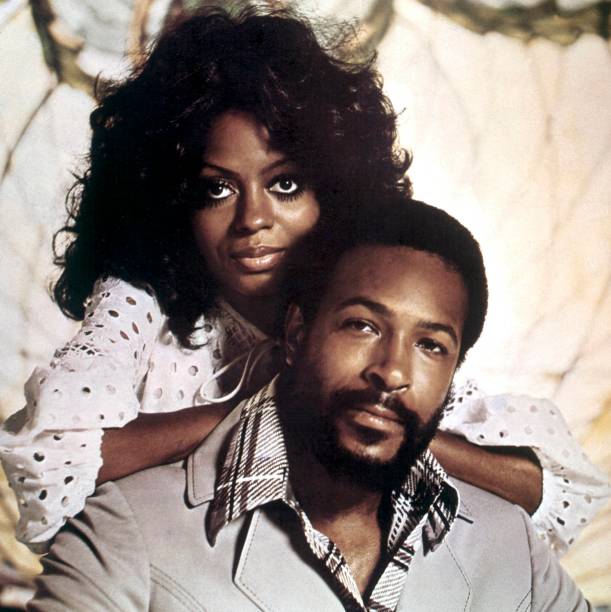
Diana Ross paid tribute to Marvin Gaye late that year on her song “Missing You.” The single reached #1 on the Billboard R&B chart and #10 on the Billboard Hot 100.
In January on 1985 Motown label-mates the Commodores, also paid tribute to Marvin Gaye, and Jackie Wilson with the gold #1 single “Nightshift.” Both singers died in 1984.

The magnitude of Marvin Gaye’s influence on R&B and soul music was recognized when he was inducted into the Rock and Roll Hall of Fame in 1987.
His music continues to influence and inspire singers and songwriters today.
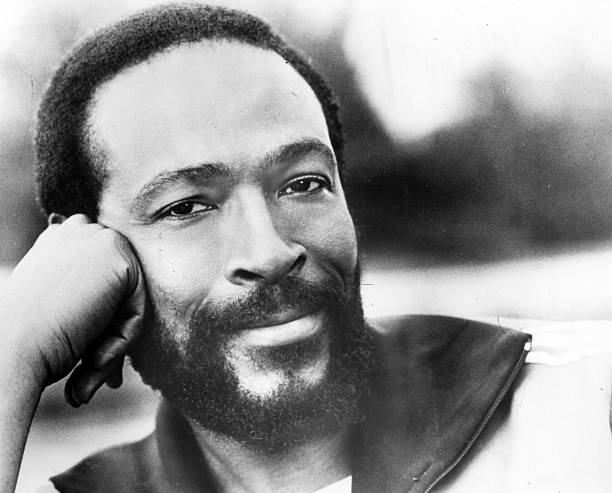
Marvin Gaye Number 1’s!
LET’S GET IT ON
(Marvin Gaye-Ed Townsend)
Produced by Marvin Gaye and Ed Townsend
#1 Pop (2 weeks) and R&B (6 weeks), 1973GOT TO GIVE IT UP – Pt. I
(Marvin Gaye)
Produced by Art Stewart
#1 Pop, R&B and Dance/Disco (5 weeks), 1977SEXUAL HEALING
(Marvin Gaye-David Ritz-Odell Brown)
Produced and Arranged by Marvin Gaye
#1 R&B (10 weeks), 1982-83WHAT’S GOING ON
(Al Cleveland-Marvin Gaye-Renaldo Benson)
Produced by Marvin Gaye
#1 R&B (5 weeks), 1971
AIN’T NOTHING LIKE THE REAL THING – duet with Tammi Terrell
(Nickolas Ashford-Valerie Simpson)
Produced by Nickolas Ashford and Valerie Simpson
#1 R&B, 1968TOO BUSY THINKING ABOUT MY BABY
(Norman Whitfield-Janie Bradford-Barrett Strong)
Produced by Norman Whitfield
#1 R&B (6 weeks), 1969AIN’T THAT PECULIAR
(William “Smokey” Robinson-Marvin Tarplin-Ronald White)
Produced by Smokey Robinson
#1 R&B, 1965I HEARD IT THROUGH THE GRAPEVINE
(Norman Whitfield-Barrett Strong)
Produced by Norman Whitfield
#1 Pop (7 weeks) and R&B (5 weeks), 1968
I WANT YOU
(Leon Ware-T-Boy Ross)
Produced by Leon Ware and T-Boy Ross
#1 R&B, 1976MERCY MERCY ME (THE ECOLOGY)
(Marvin Gaye)
Produced by Marvin Gaye
#1 R&B (2 weeks), 1971INNER CITY BLUES (MAKE ME WANNA HOLLER)
(Marvin Gaye-James Nyx)
Produced by Marvin Gaye
#1 R&B (2 weeks), 1971
YOU’RE ALL I NEED TO GET BY – duet with Tammi Terrell
(Nickolas Ashford-Valerie Simpson)
Produced by Nickolas Ashford and Valerie Simpson
#1 R&B (5 weeks), 1968I’LL BE DOGGONE
(William “Smokey” Robinson-Warren Moore-Marvin Tarplin)
Produced by Smokey Robinson
#1 R&B, 1965

